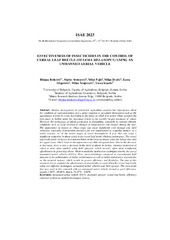Приказ основних података о документу
EFFECTIVENESS OF INSECTICIDES IN THE CONTROL OF CEREAL LEAF BEETLE (OULEMA MELANOPUS) USING AN UNMANNED AERIAL VEHICLE
| dc.creator | Bošković, Biljana | |
| dc.creator | Sretenović, Marko | |
| dc.creator | Pajić, Miloš | |
| dc.creator | Dražić, Milan | |
| dc.creator | Gligorević, Kosta | |
| dc.creator | Šunjevarić, Milan | |
| dc.creator | Kandić, Vesna | |
| dc.date.accessioned | 2023-12-07T13:38:22Z | |
| dc.date.available | 2023-12-07T13:38:22Z | |
| dc.date.issued | 2023 | |
| dc.identifier.isbn | 978-86-7834-423-7 | |
| dc.identifier.uri | http://aspace.agrif.bg.ac.rs/handle/123456789/6541 | |
| dc.description.abstract | Modern management of sustainable agriculture requires fast information about the condition of cultivated plants and a quick response to unwanted phenomena such as the appearance of pests in crops. According to the areas on which it is grown wheat occupies the first place in Serbia while the European Union is the world’s largest producer of wheat. However, the technology of wheat production is demanding, especially in extreme climatic conditions such as large oscillatory changes in temperatures and rainfall during the year. The appearance of insects in wheat crops can cause significant crop damage and yield reduction, especially if protection measures are not implemented in a quality manner, in a timely manner, i.e. in the initial stages of insect development. A pest that can cause a significant reduction in wheat yields is the cereal leaf beetle (Oulema melanopus). The cereal leaf beetle feeds on leaves that remain bitten in the form of stripes while the larvae bite only the upper layer, which leads to the appearance of white elongated lines. Due to the decrease in leaf mass, there is also a decrease in the yield of wheat. In Serbia, chemical protection of wheat is most often applied using field sprayers, which recently often show insufficient effectiveness in protecting wheat. Modern pesticide application techniques involve the use of unmanned aerial vehicles (UAVs). Their main advantage compared to conventional field sprayers is the achievement of higher performance as well as better distribution of pesticides on the targeted surface, which results in greater efficiency and flexibility. The aim of this research was to examine the effectiveness of insecticides in controlling the cereal leaf beetle using two different techniques, unmanned aerial vehicles and field sprayer. The insecticide that was used in this research with an unmanned aerial vehicle showed a high efficiency, namely 3 DPT - 94.67%, that is, 97.46% - 9 DPT. | sr |
| dc.language.iso | en | sr |
| dc.publisher | University of Belgrade, Faculty of Agriculture, Serbia | sr |
| dc.rights | openAccess | sr |
| dc.rights.uri | https://creativecommons.org/licenses/by/4.0/ | |
| dc.source | ISAE 2023 The 6th International Symposium on Agricultural Engineering | sr |
| dc.subject | unmanned aerial vehicle (UAV) | sr |
| dc.subject | knapsack sprayer | sr |
| dc.subject | cereal leaf beetle | sr |
| dc.subject | efficiency chemical protection | sr |
| dc.subject | modern techniques | sr |
| dc.subject | insects | sr |
| dc.title | EFFECTIVENESS OF INSECTICIDES IN THE CONTROL OF CEREAL LEAF BEETLE (OULEMA MELANOPUS) USING AN UNMANNED AERIAL VEHICLE | sr |
| dc.type | other | sr |
| dc.rights.license | BY | sr |
| dc.identifier.fulltext | http://aspace.agrif.bg.ac.rs/bitstream/id/25201/Boskovic_ISAE2023.pdf | |
| dc.identifier.rcub | https://hdl.handle.net/21.15107/rcub_agrospace_6541 | |
| dc.type.version | publishedVersion | sr |


